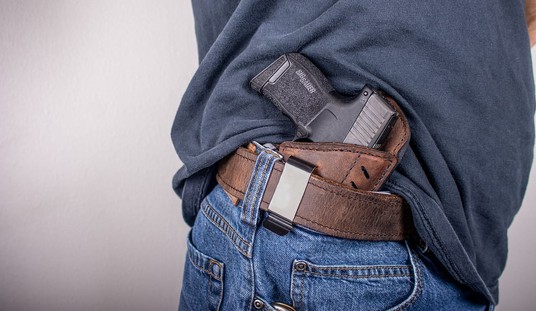
58-year-old Ernst Mauch was one of the top engineers for Heckler & Koch, the famed German defense manufacturing company.
He worked on some of the company’s most iconic firearms, including the HK416, a variant of the M4 carbine that used a proprietary short-stroke gas piston upper. The HK416 was later adopted—with some minor tweaks—as the U.S. Marine Corps M27 Infantry Automatic Rifle, a replacement for the M249 Squad Automatic Weapon.
A devout Christian, Mauch has wrestled with apparent conflicts between his faith and his career for decades. It was hard for him to reconcile a faith that teaches “thou shall not murder” with the creation for firearms. For years, it was enough for him that he was designing weapons primarily for NATO military and allied police forces… those presumably acting on the side of peace, for good.
A moment came, however, when he wondered if he was doing enough to ensure that people weren’t dying unnecessarily due to his work.
In a Washington Post interview, Mauch describes the pivotal moment in his life that inspired him to seriously begin considering smart gun designs:
Mauch came home to that family one day in the 1990s following four hours of questioning by authorities after a boy accidentally killed a friend with one of Heckler & Koch’s handguns. “Why did the boy not know the gun was loaded?” Mauch was asked. “Why did the boy not know there was a round in the chamber?”
He told his wife, “My dear, I will never forget these last four hours.”
The questions, Mauch said, were good ones. “It was a good gun,” he said. “A good gun, but a dumb gun.” The idea of making guns smarter took hold.
I empathize with Mauch, and his crisis of conscience. It makes perfect sense that a man in his position, with his talents and concerns, would want to reduce the likelihood of accidental firearms deaths. They are, after all, a concern of every responsible gun owner.
Mauch eventually left Heckler & Koch in 2005, and joined Armatix in 2006. His first project was the iP1/iW1 pistol and watch combination, a firearm developed for the United States civilian pistol market. He’s spent 8 long years developing the technology, even pouring in his own money to help finance the development of the system.
It was—and remains, despite Mauch’s best intentions—a pistol that gun owners don’t want.
[continues on next page]

While the Washington Post storyteller Michael S. Rosenwald goes off the rails and claims that “the National Rifle Association and other gun groups fiercely oppose smart guns,” the claim simply isn’t true.
Neither the NRA, nor the association of firearms manufacturers known as the National Shooting Sports Foundation (NSSF) oppose advances in smart gun technology. The reality is that private gun manufacturing has been responsible for almost all technological innovation in the firearms industry in the United States since colonial times, with the government (especially the military) typically being dragged kicking and screaming to adopt technological advances created by civilian gun companies.
What many people opposed is a draconian law in New Jersey mandating the exclusive adoption of so-called “smart guns,” once they are available for sale anywhere in the United States, even though the technology is still very much in its infancy, and not ready for prime time.
Not ready for commercial use?
Mr. Mauch would like to believe that his firearm is ready for commercial sale in the United States. If I’d spent the last eight years of my life, my reputation, and significant amounts of my personal fortune in developing something, I’d also want it to be a success.
Unfortunately for Mr. Mauch, the iP1/iW1 fails on a number of levels, far beyond the legislative mandates that New Jersey Democrats could easily overturn if they seriously wanted such firearms to be accessible.
The Armatix design is a practical failure, in almost every conceivable way.
Cost
The most obvious and self-evident problem with the iP1 pistol/iW1 sensor/watch combination is the cost of the system. The iPw pistol is sold at a price of $1,400, and requires the $400 watch to function. Reliable pistols with the same general characteristics ( a compact semi-automatic pistol with a 10-shot magazine, chambered in .22LR caliber) can be had from $250 from the industry’s top brands, including Beretta and Ruger.
Why would anyone want to pay$1,800—620% more—for an unproven handgun design, from an unproven brand, with no track record of success, with built-in failure points as its primary selling point?
Value
The iP1/iW1 is chambered in .22LR, an inexpensive, low-recoiling, and common cartridge used for firearms training, small game hunting, and pest eradication. The majority of pistols chambered in this caliber are not defensive weapons, and are typically stored locked in a gun cabinet or a gun safe. A person worried about unauthorized users acquiring his or her .22LR pistol can easily purchase a gun and a locking safe for the pistol for $300-$350, and have a comparable level of safety.
The only way that the iP1/iW1 combination provides more security is if the owner violates every NRA rule of gun safety, and leaved an unsecured, loaded firearm when an unauthorized user can easily access it. This is already fortunately rare, and the number of accidental gun deaths is already on a long-term decline.
There is no practical value in such a novelty.
Defensive Utility
As noted above the iP1/iW1 is chambered in .22LR, a cartridge useful for target shooting, the hunting of rabbits and squirrels, and the killing of pests, but which lacks the power to be considered adequate for self-defense purposes. Most firearms experts consider the .380 ACP the absolute minimum acceptable caliber for a self-defense/back-up/concealed carry pistol, and even that recommendation relies upon premium defensive hollowpoint or frangible ammunition. Most western law enforcement and military forces use the 9mm as their minimum acceptable caliber, which is more than four times as powerful (in terms of ft/pounds of energy) as the anemic .22LR.
Design Flaws
While supporters of so-called “smart guns” love to tout that the pistols have the “advantage” of not working unless a very specific number of things happen in a precise sequence, they seem to forget the biggest detriment to these systems: they don’t work unless a very specific number of things happens in a precise sequence.
This may only be an annoyance when at the range shooting at paper targets, but such system sensitivity can get you killed and your family killed in a defensive situation.
There is the reason why no military or police unit in the entire world dares issue such fragile technology to people who need to be able to trust their lives to reliable firearms.
Let’s look at a “typical” defensive handgun use, versus a likely Armatix iP1/iW1 defensive handgun use.
[continues on next page]
A generic 9mm semi-automatic handgun
A homeowner wakes in the middle of the night to the sound of breaking glass. He gets out of bed, and quickly crosses the room to the small gun safe in his bedroom closet. He punches in the six-digit code, and then withdraws the loaded 9mm handgun from the safe as his wife dials 911. He then takes a barricade position where he can cover the hallway leading to the family’s bedrooms, and shouts a warning to the intruder. He minimizes his exposure from his position by shifting the gun to his left hand, moving the bulk of his body behind the doorframe and wall as he was trained.
He sees the home invader start down the hallway despite his warning, and opens fire. He strikes the intruder, and the home invader turns to flee. The home invader is found several blocks away by responding police, and is arrested.
The entire home invasion lasted no more than 30 seconds, and the homeowner was able to acquire a firing grip on a completely functional handgun inside 10 seconds.
An Armatix iP1/iW1 gun watch combination
A homeowner wakes in the middle of the night to the sound of breaking glass. He gets out of bed, and quickly crosses the room to the small gun safe in his bedroom closet.
He punches in the six-digit code, and then withdraws the Aramtix iW1 sensor/watch that he keeps inside.
He straps on the iW1, and punches in the PIN code, so that his gun will talk to his watch.
He then withdraws the loaded .22 LR iP1 pistol that he keeps inside to defend his family as his wife dials 911. He takes a barricade position where he can cover the hallway. He can’t see very far, as the green glow from the back of the Armatix that lets him know it is ready to fire is obstructing his night vision. The green glow serves as a convenient aiming point for the intruder who sees him first, and who decides to open fire, without warning.

Fortunately, the intruder isn’t a marksman, and his first shot whistles past the startled homeowner, down the hallway into his daughter’s bedroom, where it harmlessly penetrates the wall over her bed and exits the vinyl siding of the home.
The homeowner ducks back into his room and switches the Armatix iP1 to his left hand, so that he can fire through the doorway without exposing his entire body to the armed attacker. He points the gun down the hallway, and squeezes the trigger.
Nothing happens.
The iP1 glows red instead of green. The iW1 sensor/watch is on the wrong hand, and is more than ten inches away from the pistol. It will not work, by design. The frustrated homeowner switches hands again. The iP1 glows green.
By now, the intruder has advanced down the hallway, and he fires again as the green glow comes into view. This time he scores a hit; the homeowner feels a twinge in his upper chest as the bullet strikes, but he’s concentrating on firing the Armatix, and quickly fires all ten rounds of .22LR as the intruder closes in. Three of the ten shots actually strike the attacker, which is slightly better than average than the police do when a criminal is shooting at them. Unfortunately, the .22LR rounds are not very effective, and the intruder fires several more rounds before withdrawing. He’ll drive himself to the local hospital the next morning, claiming that he was injured while hunting. He’ll be arrested soon afterward.
The homeowner is suffering from a chest wound when the police arrive, but paramedics are able to stabilize him and get him to the hospital. He’ll pull through.
The entire home invasion lasted no more than 60 seconds, and the homeowner was able to acquire a firing grip on a completely functional handgun inside 20 seconds the first time, and reacquired a functional firing grip again at the 40-second mark.
[continues on next page]
Conclusions
The Armatix is an extremely expensive, poorly thought out, technologically complex and fragile answer to a training problem.
A responsible gun owner is going to follow the NRA and NSSF safety rules, and will keep firearms locked away where they cannot be accessed by unauthorized users. Responsible gun owners will not willingly spend 3 times what they need to for an immature, unreliable firearm that does not work in real-world situations in a timely manner.
The Armatix iP1/iW1 was created by a man from a nation where handgun ownership is incredibly rare, where citizens (including gun designers) don’t know how to use handguns, in a culture with a reputation for designing needlessly complex, expensive, and failure-prone weapon systems.
Rational, knowledgeable persons with competent handgun training will not buy an Armatix iP1/iW1 “smart gun” by choice.
They’re far too smart to talked into buying such a dumb system.









Join the conversation as a VIP Member